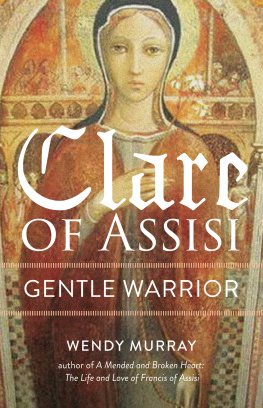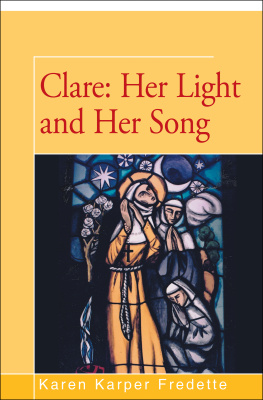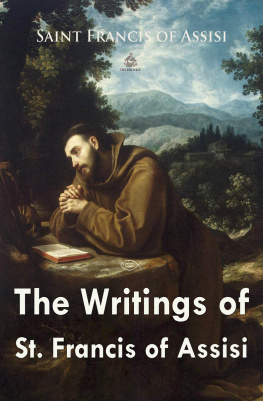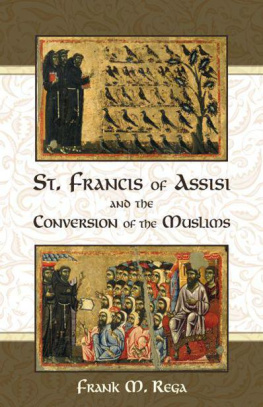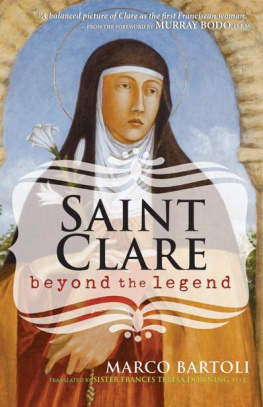Contents
Page List
Guide
Clare
OF ASSISI
GENTLE WARRIOR
WENDY MURRAY

2020 First Printing
Clare of Assisi: Gentle Warrior
Copyright 2020 by Wendy Murray
Cat drawing by Jon Zoba
ISBN 978-1-64060-183-3
Cover image: Santa Chiara (Opera Unica) by Elvio Marchionni. 70 x 77.5 cm. Mixed media on plaster. Used by permission.
The Paraclete Press name and logo (dove on cross) and the San Damiano Books logo are trademarks of Paraclete Press, Inc.
Library of Congress Cataloging-in-Publication Data
Names: Murray, Wendy, 1956- author.
Title: Clare of Assisi : gentle warrior / Wendy Murray, author of A mended and broken heart: the life and love of Francis of Assisi.
Description: Brewster , Massachsetts : San Damiano Books, Paraclete Press, 2020. | Includes bibliographical references and index. | Summary: Clare is shown as a figure of true heroism, tenacity, beatitude and grit who plotted her improbable course in the context of the raucous and explosive period of the Middle Ages-- Provided by publisher.
Identifiers: LCCN 2020006805 | ISBN 9781640601833 (trade paperback) Subjects: LCSH: Clare, of Assisi, Saint, 1194-1253. | Poor Clares--History. | Poor Clares--Biography. | Franciscans--Biography. | Christian women saints--Italy--Assisi--Biography. | Christian saints--Italy--Assisi--Biography.
Classification: LCC BX4700.C6 M87 2020 | DDC 271/.97302 [B]--dc23
LC record available at https://lccn.loc.gov/2020006805
10 9 8 7 6 5 4 3 2 1
All rights reserved. No portion of this book may be reproduced, stored in an electronic retrieval system, or transmitted in any form or by any meanselectronic, mechanical, photocopy, recording, or any otherexcept for brief quotations in printed reviews, without the prior permission of the publisher.
Published by Paraclete Press
Brewster, Massachusetts
www.paracletepress.com
Printed in the United States of America
CONTENTS
ABBREVIATIONS
All material taken from Francis of Assisi:
Early Documents and Clare of Assisi: Early Documents is denoted in the notes as FA:ED and CA:ED, respectively.
1LAg The First Letter to Blessed Agnes of Prague (1234)
2LAg The Second Letter to Blessed Agnes of Prague (1235)
3LAg The Third Letter to Blessed Agnes of Prague (1238)
4LAg The Fourth Letter to Blessed Agnes of Prague (1253)
FLCl The Form of Life (1253)
TestCl The Testament (1247-1253)
BlCl The Blessing
PrPov The Privilege of Poverty of Pope Gregory IX (1228)
FLInn The Form of Life provided by Pope Innocent IV (1247)
PC The Acts of the Process of Canonization (1253)
VL The Versified Legend (1254-1255)
BC The Bull of Canonization (1254)
LCl The Legend of Saint Clare (1254-1255)
Franciscan Biographical Writings
1C The First Witness of Thomas of Celano (1228)
2C The Second Witness of Thomas of Celano (1245-1247)
AP The Witness of the Anonymous of Perugia (1240-1241)
L3C The Legend of the Three Companions (1241-1247)
AC The Assisi Compilation (1244-1260)
LJS The Life of Saint Francis, Julian of Speyer
MP Mirror of Perfection
LegMaj Major Legend of Bonaventure
VL The Versified Life of Saint Francis by Henri dAvranches
PREFACE
D uring a recent visit to Assisi, I chatted frequently with a British couple with whom I shared a breakfast table at the guest house where we were staying. After three breakfasts, they realized I had already written a book about Saint Francis and that the book happened to be available for purchase in the library of the guest house. On their last morning in Assisi, before this couple began the long trek hauling their bags to the train station, the gentleman asked if I would sign the copy of my book he had purchased from the library, which I was happy to do. And off they went. Then, as if in an afterthought, his wife quickly returned to tell me, with wetness in her eyes: After speaking with you, I understand the feeling I had when I visited San Damiano. (San Damiano is the small convent below town that Francis rebuilt and where Clare of Assisi lived out her days.) I asked her, What feeling? She said, I felt sadness there, almost as if someone had died.
I probed my memory trying to recall what I had said that had awakened such clarity on her part. I recalled, faintly, that I had shared with them how Saint Francis, near the end of his life, had been essentially kicked out of his own religious order, suggesting that the shifting tides of change were overtaking the idealism of his original vision.
The British womans words hung over me as I continued my research on Saint Clare. By the end of my trip, I felt a similar sadness. I felt it when I stood in the Basilica of Saint Clare, with its vaulted ceilings covered top-to-bottom in whitewash, with only a few partial glimpses of old frescoes underneath the white in random spots. The story of Clare must have certainly been told through fresco cycles, as was the case of the Basilica of Saint Francis on the other side of townthis was the function and purpose of basilicas. Yet, if there had been any frescoes depicting Clares life, they had been covered over. I overheard a tour guide explain it, saying that in the sixteenth and seventeenth centuries, during two separate outbreaks of the plague, the basilica had been turned into a hospital and the whitewash was installed for hygienic and cleaning purposes. He added that there was no intention to restore the artwork underneath. Clares story, he said, was hidden beneath the whitewash and there it would remain. This made me sad.
Where you are still able to find images of Clare in frescoes out and about in Assisi, most depict her as thick-jawed, sometimes dour, and wrapped heavily in black. Yet Clare was beautifulshe was the town beauty in Assisi during her youthand many men, Francis among them, were enamored of her. She was light-filled and brave, kind and lively. Even before her commitment to a religious life, she gave food to the poor from her table in the palazzo in Assisis wealthy neighborhood of San Rufino. She dismissed out of hand, even as a young maiden, expectations and overtures of betrothal that befit a woman of rank in that town. But the Clare you see in the frescoes show her to be stern, maybe a little dowdy, and sometimes skulking, like a caricature of the nuns you hear about in stories of Catholic boarding schools. This, too, caused me sadness.
Yet, there is one fresco that is extravagantly displayed around town being marketed as the image of Clare. It is a portrait by the pre-Renaissance artist Simone Martini, who painted several portraits of members of the noble and regal class who followed Saint Francis. One portrait among these five depicts a stately woman whose visage is calm and lovely; she is draped in delicate linens and crowned with a corona of stars (see page 196). You see it everywhere in Assision postcards, ceramics, in any number of diverse artistic reproductions. This image, of all images, captures the evanescent beauty and dignity of Clare. The problem is, the image is not Clare. Though it is marketed aggressively as Clare, the face belongs to another devoted female follower of Francis who, like Clare, was a woman of rank: Jacopa dei Settisoli, who hailed from Rome and was with Francis when he died. We know this because the corona surrounding the face, mentioned above, is not a crown of stars but of

